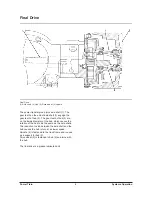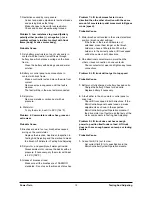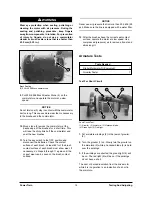
Power Train
Testing And Adjusting
4.
Control panel operation not correct:
See the MicroController System Operation
module.
5.
Brushes are worn:
Inspect the drive motor commutator for burnt
marks or scoring (scratches). Make corrections
or make a repair of the armature commutator
and replace the brushes as necessary.
See Armature Commutator Inspection and
Brush Inspection in Testing And Adjusting.
Make reference to Problem: Sparks At The
Commutator And/Or Rapid Brush Wear.
6.
Check for opens in the field coils:
Test coils according to procedures in Testing
And Adjusting. If there are opens, make a
replacement of the field assembly.
7.
Check for a short circuit in the armature windings:
Loose field winding pole pieces, make the
necessary corrections.
Field armature bar insulation.
Repair or rebuild the insulation or make a
replacement of the armature.
8.
Static return to off circuit actuated:
If the static return to off is actuated, the control
will not start again until the accelerator is
released and the directional control lever is
returned to neutral.
Problem 2: Traction will not operate through a
normal work period, but hydraulic operation is
normal.
Probable Cause:
1.
Brakes have a defect, cause a resistance (lack of
free movement). Heat increases, which causes the
motor to stall:
Check the brake adjustment according to the
procedures in Testing And Adjusting in the
Vehicle Systems module.
2.
Too much heat in MicroController control panel
because:
a.
Extra heavy traction loads.
Decrease the duty cycle load.
b.
Faulty thermal switch.
See the MicroController System Operation
module.
c.
Too high current limit (C/L) setting.
Lower the setting on the C/L adjustments.
These can cause transistors to become defective,
control panel failure or drive fuse to go bad.
Problem 3: Neither traction or hydraulic will last
through a complete normal work period.
Probable Cause:
1.
Too small a battery equipped in the lift truck:
Use a larger battery for the complete work cycle
and normal work period.
2.
Battery not being fully charged or equalized during
the battery charging operation:
Check the battery cells for an equalization
charge (a charge to make the specific gravity
the same in all cells). Check the battery charger
for defects.
3.
Battery change interval is too long or changed
battery cooling time is too short. This decreases
the capacity and the ability of the battery:
Decrease the battery work duration before a
change. Increase the battery cooling time after
a charge before it is put to use.
4.
Battery has one or more defective cells which
results in less than the rated capacity and ability of
the battery:
Replace the battery.
5.
Traction system draws (make a consumption of)
too much battery power because of traction
system faults. Operation of the duty cycle
(complete working cycle) condition is not correct:
Check the brake adjustment according to the
procedures in Testing And Adjusting in the
Vehicle Systems module, Check the mechanical
components such as wheel bearings, axles,
etc., for corrections to eliminate the faults.
Change to a tire with less friction.
6.
Hydraulic system draws too much battery power
because of lifting and tilting arrangements, or
hydraulic conditions are not correct for the duty
cycle:
Decrease hydraulic relief valve setting to the
capacity that only will be used.
Change to a smaller hydraulic pump.
Check the mast for restriction during operation.
7.
Lift truck working more than the capacity of its
design with no available power after one work
shift:
Have available an extra (exchange) battery.
Decrease the speed and work load required to
complete the work shift.
10


























